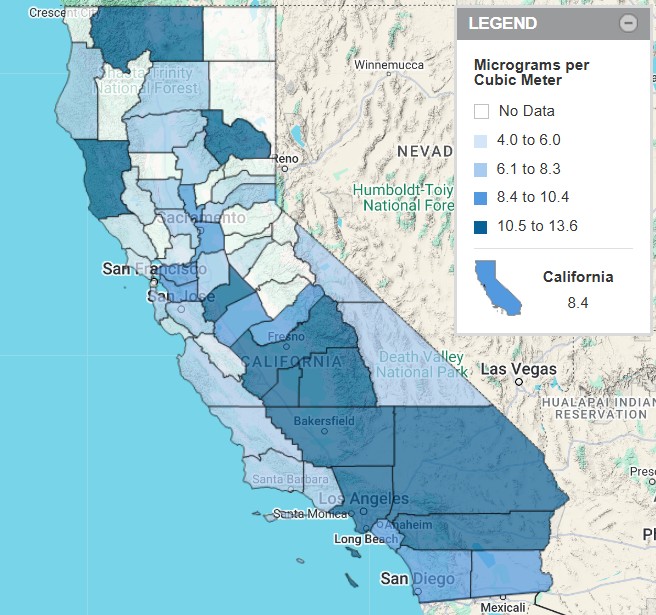Air Pollution Is a Big Problem for California’s Littlest Lungs
Air pollution threatens the health of people of all ages, but children are especially vulnerable—their bodies and vital organs are still developing, they breathe more air (and with it, pollutants) relative to their size, and they generally spend more time outside or closer to the ground, where pollutant concentrations often are highest. Children also are uniquely at risk for negative developmental outcomes associated with exposure to air pollution, which can disrupt their cognition, behavior, academic performance, and economic productivity in adulthood.
Average Concentration of Fine Particulate Matter (PM2.5) in the Air, by County: 2023
Despite its strong air quality regulations and leadership on environmental policy, California is home to some of the most polluted air in the nation. In 2023, 17 counties recorded average airborne concentrations of fine particulate matter—tiny inhalable particles (2.5 microns or smaller) emitted from vehicles, wildfires, and other natural and industrial processes—above the current national primary standard of 9 micrograms per cubic meter. Concentrations above this level have been shown to be harmful to human health, especially among sensitive groups like children. In Southern California and the San Joaquin Valley, most counties averaged unhealthy PM2.5 concentrations in 2023.
These regions also reported the most days with average ozone concentrations above the public health standard of 0.070 parts per million. Kern, Los Angeles, Riverside, and San Bernardino counties each saw at least 52 days of ozone concentrations exceeding this threshold in 2023—the equivalent of at least one unhealthy air day per week.
Protecting the air we share benefits all Californians. Read more about policy and program strategies to safeguard kids and other sensitive groups, and to reduce the disproportionate burden of air pollution in lower-income areas and among communities of color.
Health Research and Resources
California Wildfires
- A new PRB research highlight, “Wildfires Devastated Their Communities. Will Californians Stay Put?,” examines the relationship between wildfire severity and migration patterns. The evidence suggests that only the most destructive fires push people to move away from affected areas.
- The California Essentials for Childhood Initiative shares ways to help children cope with stress from wildfires, and the UCLA Center for Health Policy Research reminds us that wildfires can have long-term mental health impacts.
Medicaid
- A series of fact sheets from the Center for Children and Families at Georgetown University focuses on how Medicaid promotes maternal and infant health, serves young people with disabilities or special health care needs, and provides other essential well-being support to children and families.
- Many young adults without health insurance are eligible for Medicaid. A new brief by the Urban Institute explores the characteristics of this group to inform outreach and enrollment efforts.
Adverse Childhood Experiences
- The Children’s Partnership has released a new brief with data on adverse childhood experiences (ACEs) in California and policy recommendations for investing in whole-child systems of care.
Recently Released Data
We recently released data about air quality. See links to the latest here.
Posted by kidsdata.org
This entry was posted on Tuesday, April 29th, 2025 at 10:49 am. You can follow any responses to this entry through the RSS 2.0 feed. You can leave a response, or trackback from your own site.



